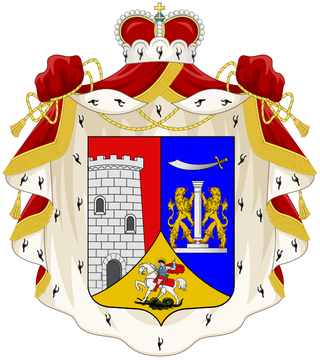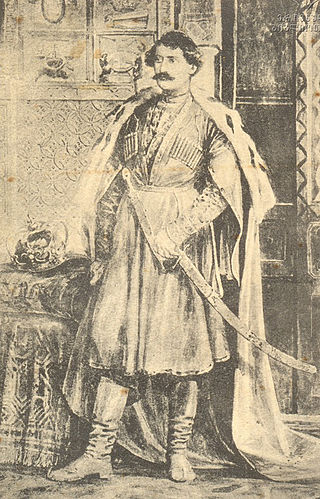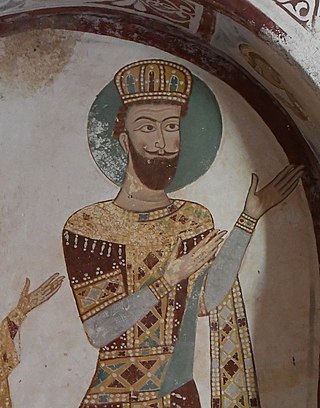See also
| Sovereign states |
|
|---|---|
| States with limited recognition | |
| Dependencies and other entities | |
For articles (arranged alphabetically) related to Georgia, see Category:Georgia (country)
The culture of Georgia has evolved over the country's long history, providing it with a unique national identity and a strong literary tradition based on the Georgian language and alphabet. This strong sense of national identity has helped to preserve Georgian distinctiveness despite repeated periods of foreign occupation.

The House of Tsereteli, also known as Tsertelev (Russian), is a noble family in Georgia which gave origin to several notable writers, politicians, scholars, and artists.

Solomon II, of the Bagrationi dynasty, was the last King of Imereti from 1789 to 1790 and from 1792 until his deposition by the Imperial Russian government in 1810.
Bagrat VI, a representative of the Imeretian branch of the Bagrationi dynasty, was a king (mepe) of Imereti from 1463, and a king of Georgia from 1465 until his death.
Vakhtang V, born Bakhuta Mukhranbatoni, was King of Kartli from 1658 until his death, who ruled as a vassal wali for the Persian shah. He is also known under the name of Shah Nawaz, which he assumed on being obliged outwardly to conform to Islam.

Alexander II was a king (mepe) of Georgia in 1478 and of Imereti from 1483 to 1510.

The Bagrationi dynasty is a royal dynasty which reigned in Georgia from the Middle Ages until the early 19th century, being among the oldest extant Christian ruling dynasties in the world. In modern usage, the name of the dynasty is sometimes Hellenized and referred to as the Georgian Bagratids, also known in English as the Bagrations.

Bagrat V (1620–1681), of the Bagrationi dynasty, was a king of Imereti, whose troubled reign in the years of 1660–61, 1663–68, 1669–78, and 1679–81, was marked by extreme instability and feudal anarchy in the kingdom.
Giorgi III Gurieli, of the Georgian House of Gurieli, was Prince of Guria from 1669 to 1684 and King of Imereti from 1681 to 1683. He was energetically involved in civil wars in western Georgian polities, which he sought to bring under his sway. He was killed in battle while trying to recover the lost throne of Imereti.

Alexander V, of the Bagrationi dynasty, was King of Imereti from 1720 his death in 1752, with the exceptions of the periods of 1741 and 1746–1749.

The nation of Georgia was first unified as a kingdom under the Bagrationi dynasty by the King Bagrat III of Georgia in the early 11th century, arising from a number of predecessor states of the ancient kingdoms of Colchis and Iberia. The Kingdom of Georgia flourished during the 10th to 12th centuries under King David IV the Builder and Queen Tamar the Great, and fell to the Mongol invasion by 1243, and after a brief reunion under George V the Brilliant to the Timurid Empire. By 1490, Georgia was fragmented into a number of petty kingdoms and principalities, which throughout the Early Modern period struggled to maintain their autonomy against Ottoman and Iranian domination until Georgia was finally annexed by the Russian Empire in the 19th century. After a brief period of independence as Democratic Republic of Georgia, the country soon ended up being a Soviet republic until the dissolution of the Soviet Union. The current republic of Georgia has been independent since 1991.

The Kingdom of Kartli was a late medieval/early modern monarchy in eastern Georgia, centred on the province of Kartli, with its capital at Tbilisi. It emerged in the process of a tripartite division of the Kingdom of Georgia in 1478 and existed, with several brief intervals, until 1762 when Kartli and the neighbouring Georgian kingdom of Kakheti were merged through dynastic succession under the Kakhetian branch of the Bagrationi dynasty. Through much of this period, the kingdom was a vassal of the successive dynasties of Iran, and to a much shorter period Ottoman Empire, but enjoyed intermittent periods of greater independence, especially after 1747.

Darejan or Nestan-Darejan (ნესტან-დარეჯანი) was a daughter of King Teimuraz I, a ruler of Kakheti in eastern Georgia, with a notable role in the contemporary politics of Georgia. Her three marriages represented a component of her family's and her own political machinations. Her first husband, Zurab, Duke of Aragvi, was put to death at the behest of Darejan's father in 1630. Her second and third marriages, to Alexander III and Vakhtang I, respectively in 1630 and 1661, made her a queen consort of Imereti, in western Georgia, where Darejan became embroiled in a series coups and counter-coups. She was eventually murdered by members of the rival party in Kutaisi.
Kaikhosro was a Georgian tavadi ("prince") of the House of Mukhrani, a collateral branch of the royal Bagrationi dynasty of Kartli. He was Prince (Mukhranbatoni) of Mukhrani, ex officio commander of the Banner of Shida Kartli, and regent of Kartli from 1625 to 1626. During the civil war in 1626, Kaikhosro sided with Giorgi Saakadze against Teimuraz I of Kakheti and followed him into exile in the Ottoman Empire, where they both, after three years of military service, were accused of treason and put to death.
Vakhtang was a Georgian prince of the Bagrationi dynasty of the Kingdom of Imereti, a younger son of King Alexander II of Imereti by his wife Tamar.
Mamia IV Dadiani was Prince of Mingrelia, of the House of Dadiani, from 1573 to 1578 and again from 1582 until his death. He was a younger son of Levan I Dadiani.
Levan III Dadiani, born Shamadavle (შამადავლე) was Prince of Mingrelia, of the House of Dadiani, from 1661 to 1680. His reign unfolded against the background of a series of civil wars in western Georgian polities, in which Levan III was an opponent of King Bagrat V of Imereti to whom he lost a battle and his own wife.
Katsia II Dadiani, of the House of Dadiani, was Prince of Mingrelia from 1758 to 1788. His rule was dominated by complicated relations with the Kingdom of Imereti, which claimed suzerainty over all of western Georgia. In efforts to further his precarious sovereignty, Dadiani easily switched sides, allying himself, alternatively, with the Imeretians, Russians, and Ottomans, as exemplified by his vacillating position during the Russo-Turkish War (1768–1774).
Mamia I Gurieli, of the House of Gurieli, was Prince of Guria from 1512 until his death in 1534. Succeeding on the death of his father Giorgi I Gurieli, Mamia became involved in the conflict between the two eastern Georgian kingdoms of Kartli and Kakheti in 1520; by force of arms, he compelled David X of Kartli to agree on peace with Levan of Kakheti, his son-in-law. Mamia Gurieli's 1533 campaign, jointly with his namesake Prince of Mingrelia, against the homebase of Circassian pirates ended in a fiasco, with Mamia being captured and ransomed later that year.